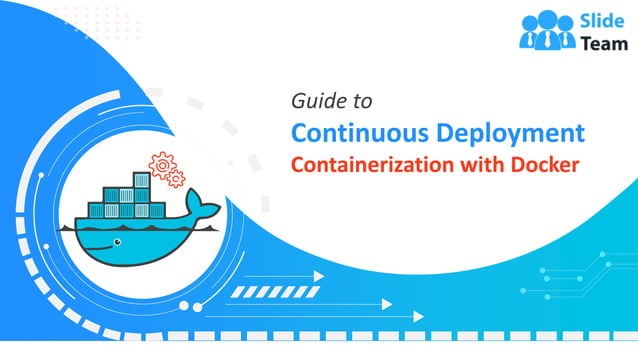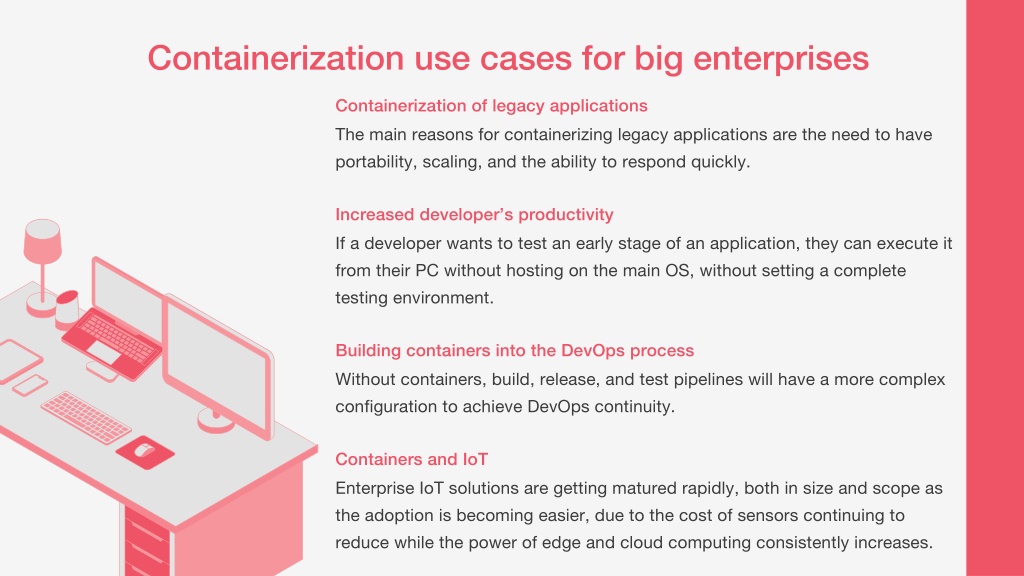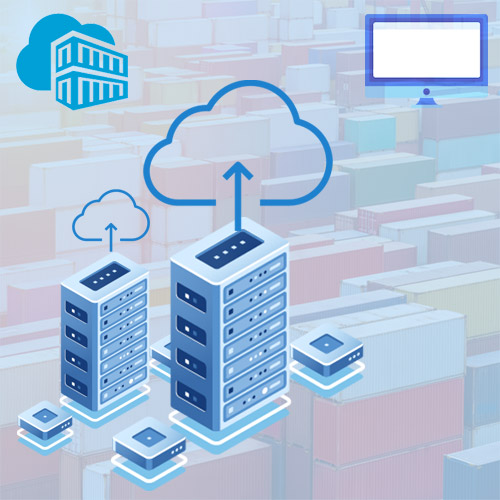Unraveling Containerization for Efficient Cloud Deployments
Containerization has emerged as a powerful and popular approach for streamlining cloud deployments. By packaging applications and their dependencies into standardized containers, organizations can achieve consistent application behavior, efficient resource utilization, and simplified management. This article delves into the concept of containerization and its growing significance in the realm of cloud computing.
Containerization essentially involves creating lightweight, portable, and self-contained units that bundle an application along with its required libraries, runtime, and configuration files. These containers can run consistently across different computing environments, ensuring that applications perform as expected, regardless of the underlying infrastructure. This level of consistency is particularly crucial in cloud deployments, where applications often need to run on various platforms and environments.
One of the primary advantages of containerization for efficient cloud deployments is resource optimization. Containers are significantly lighter than virtual machines (VMs), requiring fewer system resources. As a result, organizations can run more applications and services on the same hardware, reducing infrastructure costs and improving overall resource utilization. Additionally, containerized applications start up and stop more quickly than VMs, further enhancing efficiency and agility.
Another key benefit of containerization is the simplified management it offers. By encapsulating applications and their dependencies within containers, IT teams can reduce the complexity of managing dependencies and configurations. This approach also facilitates continuous integration and delivery (CI/CD), enabling developers to build, test, and deploy applications more rapidly and reliably. Furthermore, container orchestration tools like Kubernetes and OpenShift simplify the management of large-scale containerized applications, automating tasks such as scaling, healing, and networking.
In summary, containerization for efficient cloud deployments offers numerous benefits, including consistent application behavior, efficient resource utilization, and simplified management. As organizations continue to adopt cloud computing and DevOps practices, the demand for containerization is likely to grow, making it an essential skill for IT professionals and a critical consideration for businesses seeking to optimize their cloud deployments.
Key Containerization Technologies: A Comparative Analysis
Containerization has become an essential strategy for streamlining cloud deployments, offering efficient resource utilization, consistent application behavior, and simplified management. Among the various containerization platforms available, Docker, Kubernetes, and OpenShift stand out as popular choices. This article compares these technologies, highlighting their unique features, strengths, and limitations to help readers make informed decisions.
Docker
Docker is a leading containerization platform, providing an open-source container runtime engine that enables developers to create, deploy, and manage applications within containers. Docker’s lightweight design and compatibility with various operating systems make it an ideal choice for containerizing applications and their dependencies. Key features of Docker include:
- Simplified packaging and distribution of applications
- Isolation of applications and their dependencies within containers
- Version control and management of containerized applications
- Integration with popular CI/CD tools and cloud platforms
Kubernetes
Kubernetes is an open-source container orchestration platform designed to automate the deployment, scaling, and management of containerized applications. Built for managing large-scale container deployments, Kubernetes offers features such as:
- Automated container deployment and scaling
- Self-healing capabilities, including automatic failover and restart
- Load balancing and traffic management
- Secret and configuration management
- Integration with popular cloud platforms and tools
OpenShift
OpenShift is a containerization platform built on top of Docker and Kubernetes, providing an enterprise-ready solution for deploying and managing containerized applications. OpenShift extends Kubernetes with additional features, such as:
- Built-in developer tools and workflows
- Integrated CI/CD pipelines
- Simplified management of container images and registries
- Enhanced security features, including role-based access control and image scanning
- Support for various programming languages and frameworks
When selecting a containerization platform, it is essential to consider factors such as the size and complexity of the deployment, the required features and functionality, and the available resources and expertise. Docker, Kubernetes, and OpenShift each offer unique advantages and limitations, making them suitable for different use cases and scenarios. By understanding the key features and capabilities of these technologies, organizations can make informed decisions and optimize their containerization strategies for efficient cloud deployments.

Implementing Containerization: A Practical Guide
Containerization has become a crucial strategy for streamlining cloud deployments, offering numerous benefits such as efficient resource utilization, consistent application behavior, and simplified management. Implementing containerization, however, requires careful planning and execution. This practical guide outlines the essential steps, best practices, and tools for successful containerization implementation.
Step 1: Assessing the Application Portfolio
Begin by evaluating the application portfolio to identify suitable candidates for containerization. Consider factors such as the application’s architecture, dependencies, and resource requirements. Document these details to facilitate the containerization process.
Step 2: Selecting a Containerization Platform
Choose a containerization platform based on the organization’s needs and objectives. Popular platforms include Docker, Kubernetes, and OpenShift, each offering unique features, strengths, and limitations. Carefully evaluate these options to determine the best fit for the specific use case.
Step 3: Designing Container Images
Design container images with modularity and maintainability in mind. Minimize image size by only including necessary dependencies and components. Utilize multi-stage build processes to separate build and runtime environments, enhancing security and reducing image size.
Step 4: Implementing Container Orchestration
For large-scale cloud deployments, implement container orchestration tools like Kubernetes or OpenShift. These platforms automate container deployment, scaling, and management, ensuring high availability and resilience. Configure monitoring, logging, and alerting to maintain visibility and control over the containerized environment.
Step 5: Integrating CI/CD Pipelines
Integrate containerization into existing CI/CD pipelines to automate the build, test, and deployment processes. Leverage container image scanning tools to identify and remediate vulnerabilities before deployment, ensuring secure and compliant environments.
Step 6: Managing Configuration and Secrets
Manage configuration and secrets using tools like Kubernetes ConfigMaps and Secrets or OpenShift’s Config Operator. This approach ensures proper separation of configuration and code, simplifying management and reducing the risk of exposing sensitive information.
Step 7: Monitoring and Optimizing Performance
Monitor containerized applications and infrastructure to ensure optimal performance and resource utilization. Utilize tools like Prometheus, Grafana, or OpenShift’s built-in monitoring capabilities to collect, visualize, and analyze performance metrics. Implement autoscaling to handle fluctuations in workload and ensure high availability.
Common Pitfalls and Best Practices
Avoid common pitfalls such as overprovisioning resources, neglecting security best practices, and failing to monitor and optimize performance. Adhere to best practices like minimizing image size, separating build and runtime environments, and integrating containerization into CI/CD pipelines. Utilize essential tools like Docker, Kubernetes, or OpenShift to streamline the containerization process and ensure successful deployments.
Containerization for Efficient Cloud Deployments
Implementing containerization for efficient cloud deployments requires careful planning, execution, and ongoing management. By following the outlined steps, best practices, and utilizing essential tools, organizations can harness the power of containerization to optimize resource utilization, ensure consistent application behavior, and simplify management at scale.

Container Orchestration: Simplifying Management at Scale
Containerization for efficient cloud deployments has gained significant traction due to its ability to streamline resource utilization, ensure consistent application behavior, and simplify management. As organizations adopt containerization, managing large-scale deployments becomes increasingly complex. Container orchestration tools address these challenges, automating and optimizing container deployment, scaling, and management.
The Role of Container Orchestration
Container orchestration simplifies the management of containerized applications and infrastructure at scale. Key responsibilities include: – Automated container deployment and scaling – Resource optimization and allocation – Service discovery and load balancing – Health monitoring and self-healing – Secret and configuration management – Rolling updates and rollbacks
Popular Container Orchestration Tools
Two leading container orchestration tools are Kubernetes and OpenShift, each offering unique features and benefits:
Kubernetes
Kubernetes is an open-source platform for automating container operations. It provides a robust, flexible, and extensible solution for managing containerized applications and infrastructure at scale. Key features include:
– Automated container deployment, scaling, and management – Advanced networking capabilities – Customizable resource quotas and limits – Integrated logging and monitoring – Extensive ecosystem and community support
OpenShift
OpenShift, based on Kubernetes, is a container application platform that adds developer-centric tools and features. It simplifies the development, deployment, and management of containerized applications. Key features include:
– Built-in developer tools (IDE, source-to-image, etc.) – Streamlined application lifecycle management – Simplified cluster management and operations – Enhanced security and compliance features – User-friendly web console and CLI
Selecting the Right Container Orchestration Tool
When choosing a container orchestration tool, consider the organization’s needs, objectives, and existing infrastructure. Kubernetes offers a highly customizable, open-source solution for managing large-scale deployments, while OpenShift simplifies development and operations with a user-friendly interface and built-in tools. Evaluate these factors to determine the best fit for the specific use case.
Containerization for Efficient Cloud Deployments
Container orchestration plays a critical role in managing large-scale cloud deployments, automating and optimizing containerized applications and infrastructure. By selecting the right container orchestration tool, organizations can streamline management, reduce complexity, and ensure efficient, compliant cloud deployments.
Security Considerations for Containerized Cloud Deployments
Containerization for efficient cloud deployments has gained significant traction due to its ability to streamline resource utilization, ensure consistent application behavior, and simplify management. While containerization offers numerous benefits, it also introduces potential security risks that organizations must address to ensure secure, compliant environments.
Understanding Security Risks
Containerization introduces new security challenges, including:
– Shared kernel vulnerabilities – Container escape – Insecure container images – Inadequate network segmentation – Insufficient resource isolation – Misconfigured container orchestration
Mitigating Security Risks
To mitigate these risks, organizations can implement the following strategies:
1. Use Trusted Container Images
Only use container images from trusted sources, such as official repositories or verified publishers. Regularly scan and update container images to ensure they are free from known vulnerabilities.
2. Implement Strong Network Segmentation
Isolate container networks to prevent unauthorized access and lateral movement. Implement network policies and firewall rules to control traffic between containers and external networks.
3. Limit Resource Isolation
Configure container runtimes to limit resource access and prevent container escape. Use namespaces, cgroups, and seccomp profiles to restrict container capabilities and privileges.
4. Regularly Update and Patch
Keep container runtimes, orchestration tools, and host operating systems up-to-date with the latest security patches and updates.
5. Monitor and Audit
Implement logging, monitoring, and auditing tools to detect and respond to security incidents. Regularly review logs and audit trails to identify and address suspicious activity.
6. Secure Container Orchestration
Configure container orchestration tools, such as Kubernetes and OpenShift, with secure defaults and best practices. Implement role-based access control, network policies, and secrets management to protect sensitive data and resources.
Containerization for Efficient Cloud Deployments
Security is a critical aspect of containerized cloud deployments. By understanding potential risks and implementing best practices, organizations can mitigate security threats and maintain secure, compliant environments. This enables them to fully leverage the benefits of containerization for efficient cloud deployments.

Containerization Use Cases: Success Stories and Best Practices
Containerization for efficient cloud deployments has become increasingly popular, enabling organizations to streamline resource utilization, ensure consistent application behavior, and simplify management. This article explores real-world examples and success stories of organizations leveraging containerization, extracting best practices and lessons learned from these case studies.
Streamlining Development and Deployment
A leading software development company, XYZ Corp., adopted containerization to accelerate development cycles and improve deployment efficiency. By using Docker containers, XYZ Corp. standardized development environments, reducing time-to-market for new features and applications. The consistent application behavior provided by containerization also minimized environment-specific issues, ensuring seamless deployments across various cloud platforms.
Scaling and Managing Large-Scale Deployments
A global e-commerce platform, ABC Enterprises, leveraged containerization and Kubernetes for managing large-scale cloud deployments. By implementing container orchestration, ABC Enterprises achieved efficient resource utilization, automated scaling, and simplified management for their complex, distributed infrastructure. The adoption of containerization and Kubernetes resulted in improved application availability, reduced downtime, and enhanced customer experience.
Best Practices for Containerization
Based on these success stories, organizations can follow these best practices for containerization:
1. Standardize Development Environments
Use containerization to create consistent development environments, reducing time-to-market and minimizing environment-specific issues.
2. Implement Container Orchestration
For large-scale deployments, use container orchestration tools like Kubernetes or OpenShift to manage resources, automate scaling, and simplify management.
3. Regularly Update and Patch
Keep container runtimes, orchestration tools, and host operating systems up-to-date with the latest security patches and updates.
4. Monitor and Audit
Implement logging, monitoring, and auditing tools to detect and respond to security incidents. Regularly review logs and audit trails to identify and address suspicious activity.
5. Secure Container Orchestration
Configure container orchestration tools with secure defaults and best practices. Implement role-based access control, network policies, and secrets management to protect sensitive data and resources.
Containerization for Efficient Cloud Deployments
Containerization for efficient cloud deployments offers numerous benefits, including streamlined resource utilization, consistent application behavior, and simplified management. By learning from real-world examples and success stories, organizations can adopt best practices and strategies to maximize the potential of containerization for their cloud deployments.

The Future of Containerization: Trends and Predictions
Containerization for efficient cloud deployments has become increasingly popular, and the technology continues to evolve. As organizations rely more on cloud infrastructure, understanding emerging trends and future developments in containerization is crucial for informed decision-making. This article explores the future of containerization, focusing on trends and predictions that may impact cloud deployments and overall IT strategies.
Serverless Containerization
Serverless computing and containerization are merging, enabling organizations to run containerized applications without managing servers. This approach, known as serverless containerization, allows developers to focus on application logic while the cloud provider handles infrastructure management. By combining the benefits of serverless and containerization, organizations can achieve greater efficiency, scalability, and cost savings.
Growing Adoption of Kubernetes
Kubernetes, an open-source container orchestration platform, is expected to see continued growth in adoption. As containerization becomes more prevalent, the need for managing large-scale deployments increases. Kubernetes offers robust features for resource management, scaling, and automation, making it an ideal solution for organizations seeking to streamline containerized cloud deployments. The increasing popularity of Kubernetes will lead to more integrations, plugins, and tools, further expanding its capabilities.
Increased Focus on Security
Security remains a top concern for organizations adopting containerization for cloud deployments. As the technology evolves, so do the potential security risks. In response, the containerization landscape will focus on enhancing security features and best practices. This includes improved secrets management, network policies, and runtime security for containerized applications. By prioritizing security, organizations can ensure compliant and secure environments for their containerized workloads.
Integration with Edge Computing
Edge computing, which involves processing data closer to the source, is becoming increasingly important for IoT devices and applications. Containerization is expected to play a significant role in edge computing, as it enables efficient resource utilization and consistent application behavior. By integrating containerization with edge computing, organizations can achieve faster data processing, reduced latency, and improved user experiences.
Optimization for AI and ML Workloads
Containerization is also expected to optimize AI and ML workloads in cloud deployments. As AI and ML applications become more prevalent, organizations require efficient and scalable solutions for managing these workloads. Containerization enables consistent application behavior, simplified management, and efficient resource utilization, making it an ideal solution for AI and ML applications in the cloud.
Containerization for Efficient Cloud Deployments
Containerization for efficient cloud deployments continues to evolve, offering numerous benefits and opportunities for organizations. By staying informed about emerging trends and future developments, IT professionals can make informed decisions and adopt innovative strategies for their containerized cloud deployments.

Making the Right Choice: Selecting the Ideal Containerization Solution
Containerization for efficient cloud deployments has become increasingly popular, offering numerous benefits such as efficient resource utilization, consistent application behavior, and simplified management. As organizations consider adopting containerization, selecting the right technology and orchestration tools is crucial for successful implementation. This article provides guidance on choosing the ideal containerization solution based on specific business needs and objectives.
Understanding Your Business Needs
Before selecting a containerization solution, it is essential to understand your organization’s unique requirements. Consider factors such as the size and complexity of your applications, the scale of your cloud deployments, and your team’s expertise in containerization and orchestration tools. By aligning your containerization strategy with your business needs, you can ensure a more effective and efficient implementation.
Assessing Popular Containerization Technologies
Popular containerization platforms like Docker, Kubernetes, and OpenShift offer unique features, strengths, and limitations. Docker is widely used for creating and managing containers, while Kubernetes and OpenShift focus on container orchestration, simplifying management at scale. Assessing these technologies based on your business needs can help you make an informed decision.
Evaluating Container Orchestration Tools
Container orchestration tools like Kubernetes and OpenShift play a significant role in managing large-scale cloud deployments. When evaluating these tools, consider factors such as resource management, scalability, automation, and integration with existing infrastructure. By selecting a container orchestration tool that aligns with your business needs, you can streamline your containerized cloud deployments and improve overall efficiency.
Prioritizing Security and Compliance
Security remains a top concern for organizations adopting containerization for cloud deployments. When selecting a containerization solution, prioritize security features and best practices, such as improved secrets management, network policies, and runtime security. By ensuring secure and compliant environments, organizations can mitigate potential security risks and maintain regulatory compliance.
Leveraging Real-World Examples and Best Practices
Real-world examples and success stories of organizations leveraging containerization for efficient cloud deployments can provide valuable insights and best practices. By learning from these case studies, IT professionals can make informed decisions and adopt innovative strategies for their containerized cloud deployments.
Embracing Emerging Trends and Future Developments
Emerging trends and future developments in the containerization landscape, such as serverless containerization, integration with edge computing, and optimization for AI and ML workloads, offer opportunities for organizations to improve efficiency and scalability. By staying informed about these advancements, IT professionals can make informed decisions and adopt innovative strategies for their containerized cloud deployments.
In Summary
Selecting the right containerization solution and orchestration tools for efficient cloud deployments involves understanding your business needs, assessing popular containerization technologies, evaluating container orchestration tools, prioritizing security and compliance, leveraging real-world examples and best practices, and embracing emerging trends and future developments. By following this guidance, organizations can ensure successful implementation and reap the benefits of containerization for efficient cloud deployments.

